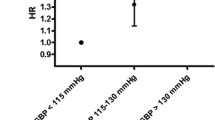Summary
This paper reviews the evidence that, in patients with hypertension, end-organ damage correlates more closely with blood pressure values obtained by ambulatory blood pressure monitoring than with those obtained by conventional sphygmomanometry. However, ambulatory blood pressure monitoring is not suitable for routine use in the clinical setting because of a lack of standard reference values and data regarding the prognostic significance of this method. Ambulatory blood pressure values are reproducible and this method avoids the so-called placebo effect; thus, this method is useful in clinical studies investigating the efficacy and duration of action of antihypertensive drugs. Data from 1 study in which hypertensive patients were treated with slow release verapamil 240mg, enalapril 20mg, nitrendipine 20mg and placebo, given once daily for 8 weeks according to a double-blind parallel group design, showed that mean 24-hour ambulatory blood pressure was reduced by all 3 drugs compared with placebo. Verapamil and enalapril showed similar antihypertensive efficacy and both drugs reduced night-time blood pressure more effectively than nitrendipine.
Similar content being viewed by others
References
Clement DL, on behalf of the Steering Committee. Office versus ambulatory recordings of blood pressure (OVA): a European multicenter study. Journal of Hypertension 8(Suppl. 6): S39–S41, 1990
Coats A, Conway J. Ambulatory blood pressure monitoring in the assessment of antihypertensive therapy. Cardiovascular Drugs and Therapy 3: 303–311, 1989
Mancia G. Ambulatory blood pressure monitoring: research and clinical applications. Journal of Hypertension 8(Suppl. 7): S1–S13, 1990
Millar Craig MW, Bishop CN, Raftery EB. Circadian variations of blood pressure. Lancet 1: 795–797, 1978
Mutti E, Trazzi S, Omboni S, Parati G, Mancia G. Effect of placebo on 24 hour non-invasive ambulatory blood pressure. Journal of Hypertension 9: 361–364, 1991
Omboni S, Ravogli A, Parati G, Zanchetti A, Mancia G. Prognostic value of ambulatory blood pressure monitoring. Journal of Hypertension, in press, 1992
Parati G, Pomidossi G, Albini F, Malaspina D, Mancia G. Relationship of 24h blood pressure mean and variability to severity of target organ damage in hypertension. Journal of Hypertension 5: 93–98, 1987
Perloff D, Sokolow M, Cowan R. The prognostic value of ambulatory blood pressure monitoring in treated hypertensive patients. Journal of Hypertension 9(Suppl. 1): S33–S40, 1991
Sluniade K, Kawamoto A, Matsubayashi K, Ozawa T. Silent cerebrovascular disease in the elderly. Correlation with ambulatory pressure. Hypertension 16: 692–699, 1990
Sokolow M, Werdegar D, Kain HK, Himan A. Relationship between level of blood pressure measured casually and by portable recorders and severity of complications in essential hypertension. Circulation 34: 279–298, 1966
Staessen J, Amery A, Clement D, Cox J, De Cort P, et al. Twenty-four hour blood pressure monitoring in the Syst-Eur trial. Ageing, in press, 1992
Trazzi S, Mutti E, Frattola A, Imholz B, Parati G, et al. Reproducibility of non-invasive and intra-arterial blood pressure monitoring. Implications for studies on antihypertensive treatment. Journal of Hypertension 9: 115–119, 1991
White W, Schulman P, McCabe UJ, Dey HM. Average daily blood pressure, not office blood pressure determines cardiac function in patients with hypertension. Journal of the American Medical Association 261: 873–877, 1989
Author information
Authors and Affiliations
Rights and permissions
About this article
Cite this article
Mancia, G., Omboni, S., Ravogli, A. et al. Ambulatory Blood Pressure Monitoring. Drugs 44 (Suppl 1), 17–22 (1992). https://doi.org/10.2165/00003495-199200441-00004
Published:
Issue Date:
DOI: https://doi.org/10.2165/00003495-199200441-00004



